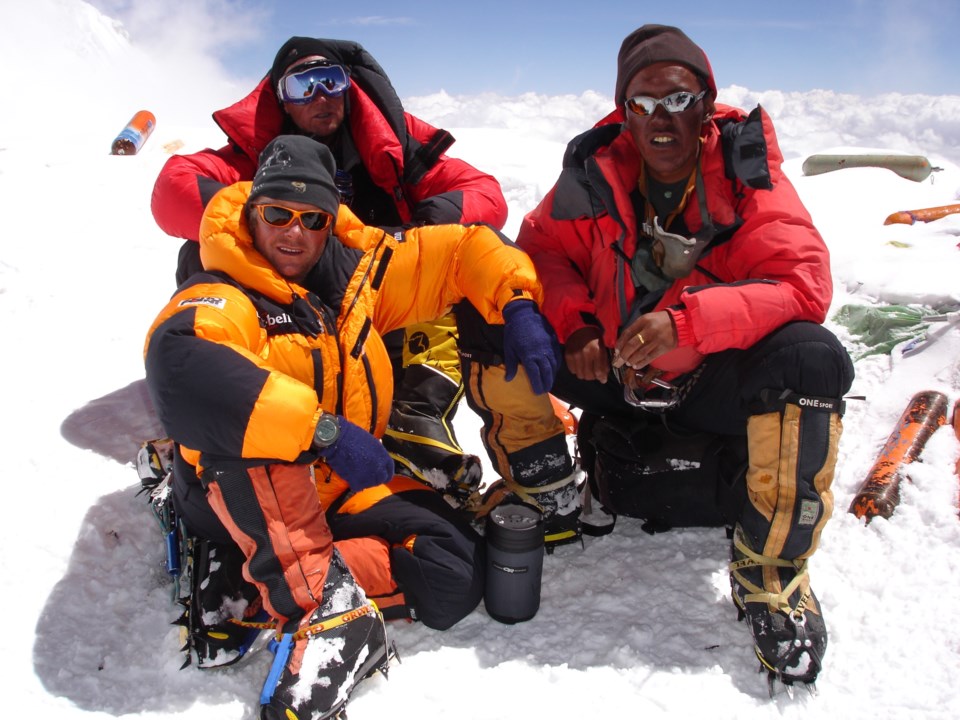Tim Calder says the desire to climb Mount Everest is more of a life-wish than a death-wish, ultimately, a bid to get the most out of life.
In 2005, he attempted to summit and came close to the top when the weather turned and a team-mate died of a heart attack.
In 2006, he tried again - this time, achieving his goal, despite three hairline fractures in his femur and a massive hematoma acquired 10 days before the expedition.
“I knew I could do it,” says Calder. “And the investment is too great to turn back when you’ve made all your plans already. I knew I wouldn’t get the opportunity again, and so I felt it was important to continue.”
The feeling at the top, he says, was a massive sense of relief mixed with a nagging sense that you need to get back down.
“It was an absolutely perfect day, and we spent about an hour and a quarter up there. You really do feel like you are on top of the world.”
In April 2014, Calder did join another expedition with plans to summit. It was the beginning of climbing season, and clients were just beginning to make their way to Base Camp. Many Sherpas were on the mountain though, setting up camps at higher altitudes. A massive ice avalanche killed 16 of them, and the incident is now considered to be one of Everest’s worst disasters.
This also marked the end of Tim Calder’s summiting ambitions.
“I noticed a real change when I returned in 2014,” says Calder. “Back in 2006, most of the people who climbed in commercial expeditions were experienced mountaineers. The price rose dramatically, making it financially inaccessible. Suddenly, you were getting more and more CEO’s, and people who seemed to like the idea of getting famous up there.”
The other big change to Everest was the arrival of 3-G wireless both at base-camp and on the mountain.
“I love the comradery, the teamwork of being on these expeditions. It used to be that while you were waiting for a weather window to open up to actually make the climb, you’d sit around at the bottom playing cards, drinking tea, getting to know people,” he says. “In 2014, you saw the shift where suddenly people spent the majority of their time on their iPads, looking at Facebook or watching videos. It’s not only that there’s a social cost to this, but there is a safety aspect too: when you are on the mountain and someone on your team gets sick, well… you want to really know each other.”
These changes, Calder says, do not impact the magic of Nepal and Everest itself.
Since the 2015 earthquake, Calder says he has focused his efforts in Nepal on fundraising for earthquake relief with a particular focus on the village of Langtang where he has longstanding connections.
“The village was totally destroyed, and a friend recieved horrendous head injuries,” says Calder. “In Nov 2015 I organized and led the first western group up to the village and we spent a week helping the few remaining villagers salvage what they could. Since then, I have tried to raise money and awareness of what happened up there, focusing in particular on getting orphaned children to school.”
He’s returned to Langtang once since then, and is now looking forward to another trip to Nepal - this time to guide a group of ten to Base Camp.
“Getting to Base Camp is not a matter of physical fitness so much as it is about acclimatization to altitude,” says Calder. “On one trip, there were two women named Margaret, one was 68 and the other was 74. They both started walking in their sixties. There was also a marathon runner who spent lots of time bouncing around from place to place, the Margarets made it to Base Camp while the marathoner had to stop due to altitude sickness. Really, to guide people to this magical place, it’s the trip of a lifetime, that’s the joy of this work.”
Calder says that his hope is to get more Canadian travellers to base camp, so is gearing up for three, possibly four more trips next year. While he has achieved his goal, and let go of the idea of reaching the summit of Everest for a second time, Calder says he hopes to be leading trips to basecamp for years to come.



